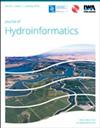A new stable and interpretable flood forecasting model combining multi-head attention mechanism and multiple linear regression
IF 2.2
3区 工程技术
Q3 COMPUTER SCIENCE, INTERDISCIPLINARY APPLICATIONS
引用次数: 0
Abstract
Abstract This article proposes a multi-head attention flood forecasting model (MHAFFM) that combines a multi-head attention mechanism with multiple linear regression for flood forecasting. Compared to LSTM-based models, MHAFFM enables precise and stable multi-hour flood forecasting while maintaining an interpretable forecasting process. First, the model utilizes characteristics of full-batch stable input data in multiple linear regression to solve the problem of oscillation in the prediction results of existing models. Second, full-batch information is connected to the multi-head attention architecture to improve the model's ability to process and interpret high-dimensional information. Finally, the model accurately and stably predicts future flood processes through linear layers. The model is applied to Dawen River Basin in Shandong, China, and experimental results show that the MHAFFM model, compared to three benchmarking models, namely, LSTM, BOA-LSTM, and MHAM-LSTM, significantly improves the prediction performance under different lead time scenarios while maintaining good stability and interpretability. Taking Nash–Sutcliffe efficiency index as an example, under a lead time of 3 h, the MHAFFM model exhibits improvements of 8.85, 3.71, and 10.29% compared to the three benchmarking models, respectively. In conclusion, this research enhances the credibility of deep learning in the field of hydrology and provides a new approach for its application.多头关注机制与多元线性回归相结合的稳定可解释性洪水预报新模型
摘要本文提出了将多头注意机制与多元线性回归相结合的多头注意洪水预测模型(MHAFFM)。与基于lstm的模型相比,MHAFFM在保持可解释的预报过程的同时,可以实现精确和稳定的多小时洪水预报。首先,该模型利用多元线性回归中全批稳定输入数据的特点,解决了现有模型预测结果振荡的问题。其次,将全批信息与多头注意架构相连接,提高模型对高维信息的处理和解释能力。最后,该模型通过线性层准确、稳定地预测未来洪水过程。将该模型应用于山东大文河流域,实验结果表明,与LSTM、BOA-LSTM和MHAM-LSTM 3种基准模型相比,MHAFFM模型在不同提前期情景下的预测性能显著提高,同时保持了良好的稳定性和可解释性。以Nash-Sutcliffe效率指数为例,在提前期为3 h的情况下,MHAFFM模型比三种基准模型分别提高了8.85、3.71和10.29%。总之,本研究增强了深度学习在水文领域的可信度,为其应用提供了新的途径。
本文章由计算机程序翻译,如有差异,请以英文原文为准。
求助全文
约1分钟内获得全文
求助全文
来源期刊

Journal of Hydroinformatics
工程技术-工程:土木
CiteScore
4.80
自引率
3.70%
发文量
59
审稿时长
3 months
期刊介绍:
Journal of Hydroinformatics is a peer-reviewed journal devoted to the application of information technology in the widest sense to problems of the aquatic environment. It promotes Hydroinformatics as a cross-disciplinary field of study, combining technological, human-sociological and more general environmental interests, including an ethical perspective.
 求助内容:
求助内容: 应助结果提醒方式:
应助结果提醒方式:


